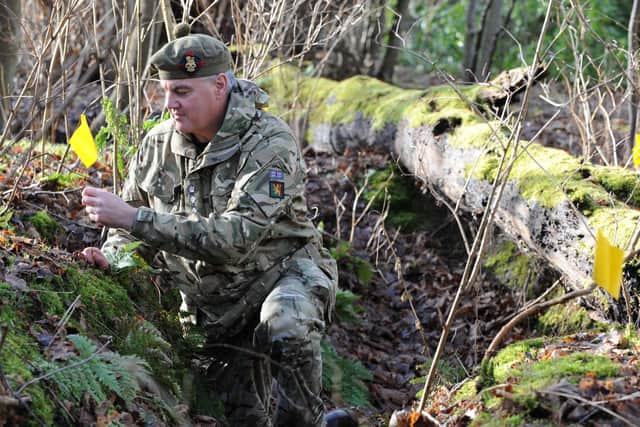First World War trenches on Capital's outskirts listed as monuments
and live on Freeview channel 276
The historic remains of First World War practise trenches on the outskirts of Edinburgh have been listed as a scheduled monument by Historic Environment Scotland.
Dreghorn Trenches, in Dreghorn wood in the Pentland Hills, were the site of training exercises carried out by British soldiers housed at nearby Redford Barracks before going to the Front.
Advertisement
Hide AdAdvertisement
Hide AdThe area was purchased by the War Department in 1913 along with Dreghorn Estate.


The remains of the trenches were discovered in 2012 by local historian and author Lynne Gladstone-Miller, whose father William had trained in the trenches before he was sent to the Somme.
Despite being shot in both legs he survived the war and was awarded the Miltary Cross.
Ms Gladstone-Miller and the Evening News successfully led a campaign to save the trenches from being destroyed by a housing development.
Advertisement
Hide AdAdvertisement
Hide AdMs Gladstone-Miller said she remembered visiting the Dreghorn trenches with her father, and him talking about the ‘special kind of mud’ that lay there.
The young recruits called this ‘Dreghorn Sludge.”
Now the future of the trenches is secured, as they have been given scheduled status, which gives statutory protection to monuments and archaelogical areas of national importance.
Scheduled monument consent will be required from Historic Environment Scotland to carry out work or development on the trenches.
The report from Historic Environment Scotland about the scheduling decision highlighted the potential for historical research to be carried out on the trenches, including the possibility of looking for artefacts buried in the mud around the area to tell us more about the kind of training given to soldiers during the first world war, and how that training changed over time.
Advertisement
Hide AdAdvertisement
Hide AdThe trenches were likely built to train soldiers from Redford Barracks, around 850m north of the site, which was built in 1909-15.
They may have also been used in training excersices at Dreghorn Barracks, which is much closer by, but was not built until the 1930s.
The trenches are one of 12 site across Scotland used for military training during the First World War, which in most cases were then re-used for other military training later in the 20th century.
However, while in most cases this later training removed all traces of First World War usage, at Dreghorn there are vital elements which survive to this day.
Advertisement
Hide AdAdvertisement
Hide AdThe report reads: “It is likely that the First World War trenches would have been constructed and used by regiments training out of Redford barracks.
“The physical remains of sites from the First World War such as the Dreghorn Woods training area have become places to visit, remember and commemorate the people who served on wartime sites such as this.
“The monument is a visible reminder of the considerable scale of infrastructure and resources and number of people required in the First World War, one of the defining events of the 20th century.”
Crucial Preservation
The move was welcomed by Royal British Legion Scotland, the remembrance charity which also supports servicemen and women returning to vivilian life after serving with the armed forces.
Advertisement
Hide AdAdvertisement
Hide AdChief Executive Dr Claire Armstrong said: “Legion Scotland is delighted to hear that the Dreghorn trenches have been listed as a scheduled monument.
“The preservation of these kinds of sites is absolutely crucial.
“It gives remembrance of the Frist World War a visual focus, and a vocal point - it keeps the legacy of the war in people’s minds.”
The trenches cover two different areas, one on each side of the Braid and Howden Burns which run through Dreghorn Wood.
Advertisement
Hide AdAdvertisement
Hide AdThe most well-preserved trenches are up to 1.5m wide and over 1m deep, with pieces of corrugated iron still supporting the sides.
Councillor Donald Wilson, culture and communities convener, said: “We very much welcome this national recognition of the importance of the Dreghorn trenches.
“Preserving them for future generations will help us all remember the thousands of Scots soldiers who lost their lives in battle”.
